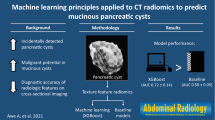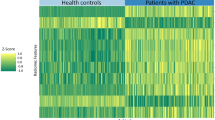Abstract
Purpose
A wide array of benign and malignant lesions of the pancreas can be cystic and these cystic lesions can have overlapping imaging appearances. The purpose of this study is to compare the diagnostic accuracy of a radiomics-based pancreatic cyst classifier to an experienced academic radiologist.
Methods
In this IRB-approved retrospective single-institution study, patients with surgically resected pancreatic cysts who underwent preoperative abdominal CT from 2003 to 2016 were identified. Pancreatic cyst(s) and background pancreas were manually segmented, and 488 radiomics features were extracted. Random forest classification based on radiomics features, age, and gender was evaluated with fourfold cross-validation. An academic radiologist blinded to the final pathologic diagnosis reviewed each case and provided the most likely diagnosis.
Results
214 patients were included (64 intraductal papillary mucinous neoplasms, 33 mucinous cystic neoplasms, 60 serous cystadenomas, 24 solid pseudopapillary neoplasms, and 33 cystic neuroendocrine tumors). The radiomics-based machine learning approach showed AUC of 0.940 in pancreatic cyst classification, compared with AUC of 0.895 for the radiologist.
Conclusion
Radiomics-based machine learning achieved equivalent performance as an experienced academic radiologist in the classification of pancreatic cysts. The high diagnostic accuracy can potentially maximize the efficiency of healthcare utilization by maximizing detection of high-risk lesions.
Graphical abstract








Similar content being viewed by others
References
Laffan, T.A., et al., Prevalence of unsuspected pancreatic cysts on MDCT. AJR Am J Roentgenol, 2008. 191(3): p. 802-7.
Zanini, N., et al., Estimation of the prevalence of asymptomatic pancreatic cysts in the population of San Marino. Pancreatology, 2015. 15(4): p. 417-22.
Zerboni, G., et al., Systematic review and meta-analysis: Prevalence of incidentally detected pancreatic cystic lesions in asymptomatic individuals. Pancreatology, 2019. 19(1): p. 2-9.
Scheiman, J.M., J.H. Hwang, and P. Moayyedi, American gastroenterological association technical review on the diagnosis and management of asymptomatic neoplastic pancreatic cysts. Gastroenterology, 2015. 148(4): p. 824–48 e22.
Elta, G.H., et al., ACG Clinical Guideline: Diagnosis and Management of Pancreatic Cysts. Am J Gastroenterol, 2018. 113(4): p. 464-479.
Valsangkar, N.P., et al., 851 resected cystic tumors of the pancreas: a 33-year experience at the Massachusetts General Hospital. Surgery, 2012. 152(3 Suppl 1): p. S4-12.
Springer, S., et al., A multimodality test to guide the management of patients with a pancreatic cyst. Sci Transl Med, 2019. 11(501): p. eaav4772.
Javed, A.A., et al., Pancreatic Fistula and Delayed Gastric Emptying After Pancreatectomy: Where do We Stand? Indian J Surg, 2015. 77(5): p. 409-25.
Megibow, A.J., et al., Management of Incidental Pancreatic Cysts: A White Paper of the ACR Incidental Findings Committee. J Am Coll Radiol, 2017. 14(7): p. 911-923.
Aerts, H.J., et al., Decoding tumour phenotype by noninvasive imaging using a quantitative radiomics approach. Nat Commun, 2014. 5: p. 4006.
Gillies, R.J., P.E. Kinahan, and H. Hricak, Radiomics: Images Are More than Pictures, They Are Data. Radiology, 2016. 278(2): p. 563-77.
Hanania, A.N., et al., Quantitative imaging to evaluate malignant potential of IPMNs. Oncotarget, 2016. 7(52): p. 85776-85784.
Permuth, J.B., et al., Combining radiomic features with a miRNA classifier may improve prediction of malignant pathology for pancreatic intraductal papillary mucinous neoplasms. Oncotarget, 2016. 7(52): p. 85785-85797.
Attiyeh, M.A., et al., Preoperative risk prediction for intraductal papillary mucinous neoplasms by quantitative CT image analysis. HPB (Oxford), 2019. 21(2): p. 212-218.
Chakraborty, J., et al., CT radiomics to predict high-risk intraductal papillary mucinous neoplasms of the pancreas. Med Phys, 2018. 45(11): p. 5019-5029.
Polk, S.L., et al., Multiphase computed tomography radiomics of pancreatic intraductal papillary mucinous neoplasms to predict malignancy. World J Gastroenterol, 2020. 26(24): p. 3458-3471.
Jeon, S.K., et al., Assessment of malignant potential in intraductal papillary mucinous neoplasms of the pancreas using MR findings and texture analysis. Eur Radiol, 2021. 31(5): p. 3394-3404.
Tobaly, D., et al., CT-Based Radiomics Analysis to Predict Malignancy in Patients with Intraductal Papillary Mucinous Neoplasm (IPMN) of the Pancreas. Cancers (Basel), 2020. 12(11).
Yang, J., et al., Discrimination of Pancreatic Serous Cystadenomas From Mucinous Cystadenomas With CT Textural Features: Based on Machine Learning. Front Oncol, 2019. 9: p. 494.
Wei, R., et al., Computer-Aided Diagnosis of Pancreas Serous Cystic Neoplasms: A Radiomics Method on Preoperative MDCT Images. Technol Cancer Res Treat, 2019. 18: p. 1533033818824339.
Xie, H., et al., Preoperative differentiation of pancreatic mucinous cystic neoplasm from macrocystic serous cystic adenoma using radiomics: Preliminary findings and comparison with radiological model. Eur J Radiol, 2020. 122: p. 108747.
Chen, S., et al., Preoperative differentiation of serous cystic neoplasms from mucin-producing pancreatic cystic neoplasms using a CT-based radiomics nomogram. Abdom Radiol (NY), 2021.
Yang, R., et al., CT classification model of pancreatic serous cystic neoplasms and mucinous cystic neoplasms based on a deep neural network. Abdom Radiol (NY), 2022. 47(1): p. 232-241.
Awe, A.M., et al., Machine learning principles applied to CT radiomics to predict mucinous pancreatic cysts. Abdom Radiol (NY), 2022. 47(1): p. 221-231.
Dmitriev, K., et al., Classification of Pancreatic Cysts in Computed Tomography Images Using a Random Forest and Convolutional Neural Network Ensemble. Med Image Comput Comput Assist Interv, 2017. 10435: p. 150-158.
Shen, X., et al., A Contrast-Enhanced Computed Tomography Based Radiomics Approach for Preoperative Differentiation of Pancreatic Cystic Neoplasm Subtypes: A Feasibility Study. Front Oncol, 2020. 10: p. 248.
Park, S., et al., Annotated normal CT data of the abdomen for deep learning: Challenges and strategies for implementation. Diagn Interv Imaging, 2020. 101(1): p. 35-44.
Chu, L.C., et al., Utility of CT Radiomics Features in Differentiation of Pancreatic Ductal Adenocarcinoma From Normal Pancreatic Tissue. AJR Am J Roentgenol, 2019. 213(2): p. 349-357.
Peng, H., F. Long, and C. Ding, Feature selection based on mutual information: criteria of max-dependency, max-relevance, and min-redundancy. IEEE Trans Pattern Anal Mach Intell, 2005. 27(8): p. 1226-38.
Funding
This research was supported by the Lustgarten Foundation.
Author information
Authors and Affiliations
Contributions
All authors contributed to the study conception and design. Material preparation, data collection, and analysis were performed by LC, SP, SS, DF, SS, and SK. The first draft of the manuscript was written by SP and all authors commented on previous versions of the manuscript. All authors read and approved the final manuscript.
Corresponding author
Ethics declarations
Conflict of interest
The authors declare no conflicts of interest.
Additional information
Publisher's Note
Springer Nature remains neutral with regard to jurisdictional claims in published maps and institutional affiliations.
Rights and permissions
Springer Nature or its licensor holds exclusive rights to this article under a publishing agreement with the author(s) or other rightsholder(s); author self-archiving of the accepted manuscript version of this article is solely governed by the terms of such publishing agreement and applicable law.
About this article
Cite this article
Chu, L.C., Park, S., Soleimani, S. et al. Classification of pancreatic cystic neoplasms using radiomic feature analysis is equivalent to an experienced academic radiologist: a step toward computer-augmented diagnostics for radiologists. Abdom Radiol 47, 4139–4150 (2022). https://doi.org/10.1007/s00261-022-03663-6
Received:
Revised:
Accepted:
Published:
Issue Date:
DOI: https://doi.org/10.1007/s00261-022-03663-6




